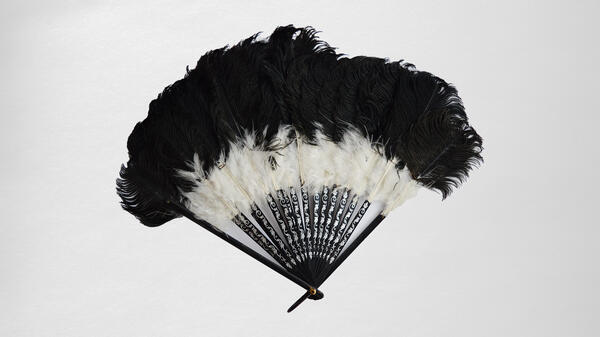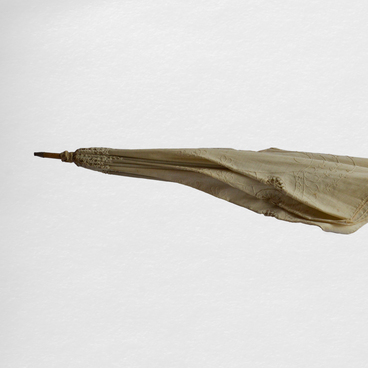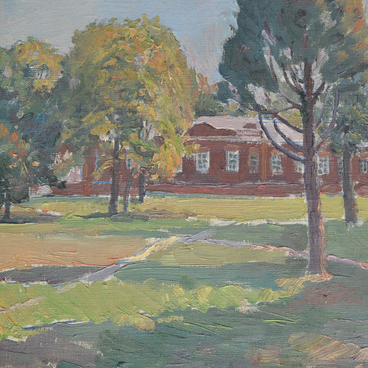The fan with ostrich feathers belonged to Pyotr Semyonov-Tyan-Shansky’s wife, Elizaveta Andreevna. Starting from the 1870s the scientist held high posts in the state hierarchy (he was head of the population census in Russia, chairman of the Statistical Council, a senator and a member of the Academy of Sciences) and often received invitations to appear at court with his wife. Nadezhda Korolkova, granddaughter of Semyonov-Tyan-Shansky, who donated the fan to the museum’s collection, noted, ‘This fan has seen three Russian emperors — Alexander II, Alexander III and Nicholas II.’ Now it is in the permanent exhibition and serves as a vivid illustration of the Semyonov-Tyan-Shansky’s family history.
This type of fans has been known in the East since ancient times — the first information about such products in China dates back to the VIII century B.C. At that time, they were made of palm and lotus leaves. Soon Japanese craftsmen invented fans from wooden planed boards, which could be folded. Such fans were first mentioned in 988.
In Europe, fans appeared in the middle of the XVI century, when the first East India companies — colonial-era trading companies — were founded. Ships brought products from distant countries, which seemed very exotic to Europeans. In the Baroque period fans became a luxury item. The materials used for their manufacture were not available to everyone. Mostly it was silk, leather, parchment or thick paper.
Over the years, the fan transformed from a tool to provide a flow of air into a real flirtation tool. There was even a special language that allowed a woman to have a conversation with her lover without resorting to words. It had many variations, varying from city to city and social circle. Usually, the simplest gesture could decide a lover’s fate — for example, a fan was moved from one hand to the other, opened (in case of a positive answer) or closed (rejection). But in the 19th century the fan lost its meaning and became a common ladies' accessory.
During this period a new trend in product design emerged — fans were ordered to match certain outfits. There were also program fans (fans given to ladies when they entered the theater), fan-menus and fans-invitation tickets. It was in the 19 century that products began to be made not only from traditional materials, but also, for example, from ostrich feathers.
It is this kind of fan that is in the collection of the manor museum. It is made of bone plates and feathers. The product is designed in strict colors — black and white. Such a fan matched the black velvet dress that the ladies of high society wore at formal events — balls, royal receptions and parties.
This type of fans has been known in the East since ancient times — the first information about such products in China dates back to the VIII century B.C. At that time, they were made of palm and lotus leaves. Soon Japanese craftsmen invented fans from wooden planed boards, which could be folded. Such fans were first mentioned in 988.
In Europe, fans appeared in the middle of the XVI century, when the first East India companies — colonial-era trading companies — were founded. Ships brought products from distant countries, which seemed very exotic to Europeans. In the Baroque period fans became a luxury item. The materials used for their manufacture were not available to everyone. Mostly it was silk, leather, parchment or thick paper.
Over the years, the fan transformed from a tool to provide a flow of air into a real flirtation tool. There was even a special language that allowed a woman to have a conversation with her lover without resorting to words. It had many variations, varying from city to city and social circle. Usually, the simplest gesture could decide a lover’s fate — for example, a fan was moved from one hand to the other, opened (in case of a positive answer) or closed (rejection). But in the 19th century the fan lost its meaning and became a common ladies' accessory.
During this period a new trend in product design emerged — fans were ordered to match certain outfits. There were also program fans (fans given to ladies when they entered the theater), fan-menus and fans-invitation tickets. It was in the 19 century that products began to be made not only from traditional materials, but also, for example, from ostrich feathers.
It is this kind of fan that is in the collection of the manor museum. It is made of bone plates and feathers. The product is designed in strict colors — black and white. Such a fan matched the black velvet dress that the ladies of high society wore at formal events — balls, royal receptions and parties.



